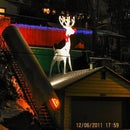Introduction: Mini-Calliope Organ
Introduction
Hello Everyone,
First, I would like to thank you for viewing my instructable.
And, if you enjoyed it, please give me a vote!
Thanks....
Although the project seems complicated, many of the parts and components are identical,
so laying out and cutting the parts isn't as time-consuming as you might expect.
You probably will need a couple of weekends to complete the project.
Guessing you will need about 40plus hours to build the calliope.
I've started this project about 30 years ago.
I was 21 at the time.
What I started I could not find (probably used for firewood),
so I started a new one from scratch this time.
I always had a subscription to Popular Mechanics.
I've had the December 1982 issue in my hands for over 30 years.
The plans and drawings can all be found in this issue.
If you don't have the issue (which I doubt you do)
Luckily I do have a link to the December 1982 issue, below.
Click here for the 1982 issue of Popular Mechanics
If you go to page 102 all the directions and plans are there.
So, in my instuctable I am not going to go in heavy detail about the making of this
calliope. I will probably direct you to the 1982 Popular Mechanics issue.
NOTE: I tried to use the hair blow dryers with no success!
They did not pull enough air.
So, as I am writing this, I am looking for a different motor.
UPDATE: I found a new blower motor with a speed control. Let's hope it works.
I will be installing it this weekend! Watch for a update and video!
Also, this instructable is a work in progress, I will be continually updating this instructable.
Now onto the instructable...
Step 1: Tools and Materials Needed
Materials needed:
(The entire list is in the Popular Mechanics link above or picture above)
White Pine wood for the cabinet.
Walnut and Aspen for the keys.
Hardwood Dowels
Fishing line
Anodized aluminum Tubing (organ pipes)
Cone Washers
Faucet Washers
Hair Dryers (which did not work)
Speed adjusting motor
Push Button Switch
and the list goes on....
Step 2: Building the Chest
To begin, cut the cabinet and wind-chest components - parts A through Q, T and U.
(see the materials list above.)
Bore pilot holes for all the screws connecting the cabinet parts with a No. 6 bit.
Counterbore all pilot holes with a 3/8" bit to receive the plugs. (V).
Then layout and bore the guide holes in the keyboard base (E) and the rocker support (I).
A drill press or drill guide is a must for accuracy.
Clamp together the tip and bottom pieces of the wind chest (parts L and N)
and bore them simultaneously so the holes will line up.
Use a depth stop to prevent from boring through the bottom board.
If you don't have a radial drill press or one with an adjustable table,
bore the angled holes in the rocker support by using shims under the workpiece
to establish the correct 5 degree angle.
Make a trial assembly of the chest.
Once everything fits properly, sand and finish the cabinet.
(step by step plans can be found from the link in the introduction page.)
Step 3: Making the Pipes
Ok, I believe the toughest part was making/forming the pipes.
Carefully follow the spec sheet above.
Particulary those concerning the sound-producing (D-shape) notches.
I used my CNC machine to cut the holes and notches. (see photos below)
If you don't own a cnc machine you can cut them with a hack-saw.
The bottom hole can be drilled out with a 5/16" bit.
Position a flue stopper of the correct size as noted in the chart and insert a cork in the bottom of each ppipe as
shown in the pipe-assembly detail.
Test each pipe by blowing gently through the 5/16" hole.
Each pipe should make a clear note.
Adjust the flue stoppers to achieve the best possible tone with the
least possible amount of air.
(step by step plans can be found from the link in the introduction page.)
Step 4: Making the Keys
Ok, next is the keys and keyboard.
Rip 7/8" strips from the type of wood of your choice.
I used a hardwood, as I did not paint my keys.
I just liked the color of the wood.
You can use the same wood as your cabinet.
Cut the white keys (parts X1, X2, X3, and X4).
Cut the black keys (Y) from 1/2" molding stock.
Bore a 1/4" holes on the undersides of the keys for the guide pins (Z).
Bore a 5/16" dimple at the back of each key.
Sand all the keys smooth, removing a total of about 1/32" from teh width of each key to ensure proper
clearance between them when they're in place.
Install the guide pins and apply several coats of spray paint to the keys.
If you are painting them, if not leave them the wood color.
As I did.
When the keys have dried, insert them through the keyboard back in order.
Insert the pivot rod (BB) through the holes in the side of the keys.
Between keys 12 and 13 (notes B and C), insert the center pivot support (CC).
Attach the two end supports (DD2) and secure the assembly with the pivot rod nuts.
Attach a lengh of foam weather-stripping (EE) to the keyboard base and install the keyboard.
Check that all keys move freely and make adjustments to the elongated guide holes where needed.
Whew..
(step by step plans can be found from the link in the introduction page.)
Step 5: Making the Rocker Assembly
Next, we begin to work on the rockers.
Cut the rockers (S) from 1/2 x 7/8" molding.
It's faster to bore pivot -rod holes and dimples before you cut the individual pieces.
Sand the sides of the rockers smooth, then add the screw hooks (HH) and counterweights (II).
Insert the pivot rod (BB) through the rockers and attach the support brackets (DD1)
Cut the push rods (AA) and install the rocker support (I) in the cabinet, threading the air hoses through the 1 3/8" holes.
Attach the height adjuster assembly (R), then insert the push rods making sure they seat in the keys' dimples.
Mount the rocker assembly on the support (I).
Adjust the height of the keys individually by screws (FF) to level the keyboard in the "up" position.
You may have to alter the lengths of some of the push rods, as well.
When the keyboard is level, the rockers should rest at approximately 15 degrees from the horizontal plane.
Finally, install the angled guide pins (GG). Establish the proper clearance by screwing the hooks (HH) in or out as needed,
Check to see that the rockers are moving freely.
(step by step plans can be found from the link in the introduction page.)
Step 6: Air-Release Assemblies
Make the 25 air-release assemblies as shown in the detail in the photo above.
Glue felt pads (QQ) to the PVC discs (00) with contact cement or other glue for non-porous surfaces.
I used 5 minute epoxy.
Fasten the hinge leaves (SS) to the bottom of the dowel (NN) and to the bottom of the wind chest with brads that come in the
hinge package.
Form the springs (TT) by cutting the heads off 1 1/2" safety pins and bending 1/8" of each cut end with
needle-nose pliers to create "ears".
Reassemble the wind chest, leaving off the top, and chalk all the joints with silicone.
Tie an 18" of braided fishing line (KK) to the screw eye on top of each dowel and thread each through its matching
nylon tubing guide (MM).
Mount the top of the chest and chalk all the joints.
(step by step plans can be found from the link in the introduction page.)
Step 7: The Blower Motors
Now onto the motors.
I selected a pair of hair driers I had on hand.
I removed the heating elements.
I wired the hair dryer motors as in the diagram.
NOTE: I tried to use the hair blow dryers with no success!
They did not pull enough air.
So, as I am writing this, I am looking for a different motor.
Step 8: New Blower Motor (as the Hair Dryers Did Not Work!)
Yes!
I found a new blower motor for the calliope.
Now, I have to figure out how to put it into the calliope.
It does have a speed adjuster on it, too!
Let's hope it works!
Out to the woodshop I go...
Step 9: Completing the Calliope
Insert the pipes through the holes in the top of the wind chest.
Manipulate the air-release assemblies by pulling on the lines until each pipe seats in the base and each felt pad seats over
the round air hole.
Glue felt strips to the back of the wind chest and install it in the cabinet.
Be sure to tighten the screws enough to compress the felt and seal the chest.
Attach the air hoses of the dryers to the copper pipe reducers (XX) mounted to the front of the wind chest.
Turn on the motor.
By pulling on the lines, you should be able to make each pipe sound in turn.
If any pipe produces a weak tone, enlarge the air hole to 3/8" diameter.
Work in order, attaching the lines to the hooks on the rockers.
Take two turns of the line around the hook, adjusting the line so it's tight, but doesn't lift the air-release assembly enough to let air enter the pipe.
Crimp a split shot on the line to secure the adjustment.
Once all 25 lines are attached, test the action of the keyboard.
If you find a sticky key (and you probably will at this point), loop a small rubber band around the base of the counterweight (II) and the
rocker guide pin (GG).
Install the music rack (J), music stop (Q) and the rocker cover (K), then apply the screw hole buttons (Y).
Finally , tune the pipes to a piano or other instrument, using the flue plugs in each pipe; pushing it in raises it.
Step 10: Painting , Handles, and Side Decorations on the Calliope
Painting the cabinet.
I used a milk paint on the cabinet.
I want to give it that old time feel.
You can find milk paint online.
I did cut my own side decorations.
I used my cnc machine.
The handles are made from a 1" dowel and 2.5" wooden balls.
Step 11: Final Pictures of the Calliope
Here are finished pictures of the calliope.
I also designed the calliope it in Sketchup.
I hope you enjoyed my instructable! ![]()

First Prize in the
Musical Instruments Contest

Participated in the
Weekend Projects Contest

Participated in the
I Could Make That Contest













